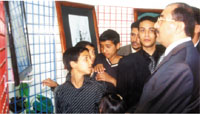
Cartoons are the art of modern prophetsSamir’s satire is highlighted [Archives:2004/790/Last Page]
November 15 2004
 |
Yemen Times Staff
Cartoonists have been called modern day prophets. And it is fair to say that cartoonist Samir Mohammed al-Shammeri is no exception, having acquired that rare talent of honestly depicting emotions and thoughts on papers with paints.
He artistically brings the critical view and laughter, forming a wonderful satire, which is not merely realized but properly felt by all audience.
In the last exhibition that started Oct. 27, he showed 'sixteen (50 X 70cm.) portraits of his, which included symbolic descriptions of different issues. Each one of them has a puzzle and the beauty of this art lies in understanding.
The exhibition was organized by the Ministry of Culture at culture house in the frame of Sana'a, the 2004 Arab Cultural Capital. It was opened by Khaled al-Rowaishan, Minister of Culture.
The successful exhibition was not only for him, but another cartoonist, Esam Talal, and three artists, Amal, Reham, Moh'd al-Shameeri, (his brother) also appeared.
He has been present throughout al-Balagh Newspaper, since 1993, and also for many years at the Yemen Times.
“Not just in this exhibition, but in the previous one that was held in April 2004, and in the booklet published about it later, besides the other three booklets, “Shrill Laughter” and the book of the capital's cleaning municipality, the focus is on the local issues.
When trying to highlight some Arab or international issues, we find ourselves repeating the same ideas. Some of them are similar to the local ones. Arabs' submissiveness, for instance, has been presented for a long time until it became a matter of routine. What makes this art interesting is its being connected with sufferings of people. So, I concentrate on the local issues more,” Samir explained.
“Some prominent events or flashes happened on the Arab and international level may be focused on,” he said.
“Our society is full of social and political subjects that deserve to be depicted. See for example the portrait titled Bara'a that describe the nature of Yemenis who dance as soon as the listen to others beating the drums even if the shadow (representing the reality) shows their miseries,” he added.
About the art of cartoon, he said that the secret of its interesting nature is that it honestly represents common people because the cartoonist is one of them. He is convincing himself while convincing others. There's no contradiction between the cartoonist's views and the others'. 'He shouldn't be confined within a limited scope, but move in all directions in order to make his works represent all classes of people. The cartoonist should be so; he shouldn't commit flattery but honestly depict his community.'
When talking about the situation of this art in Yemen, he said: “Music and painting are the most noble things all over the world, and they are underestimated in Yemen.
——
[archive-e:790-v:13-y:2004-d:2004-11-15-p:lastpage]


